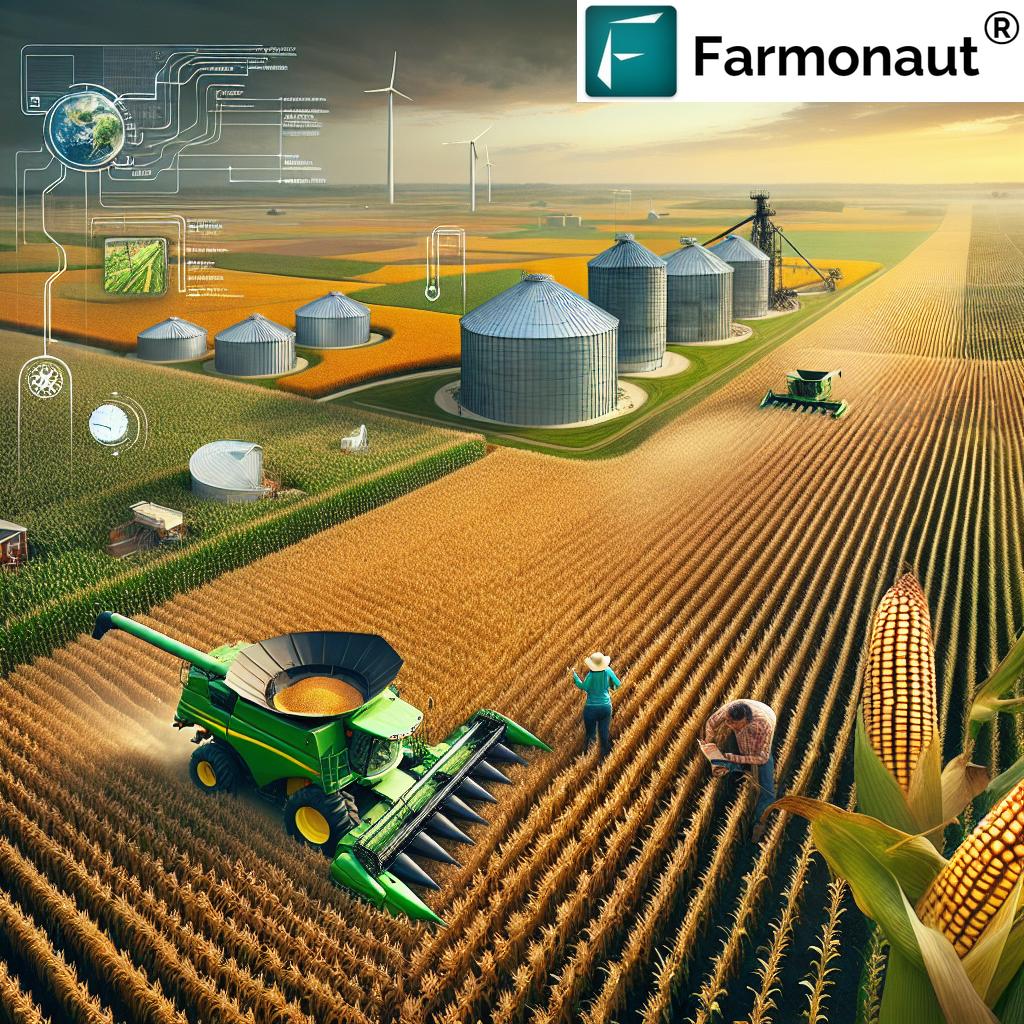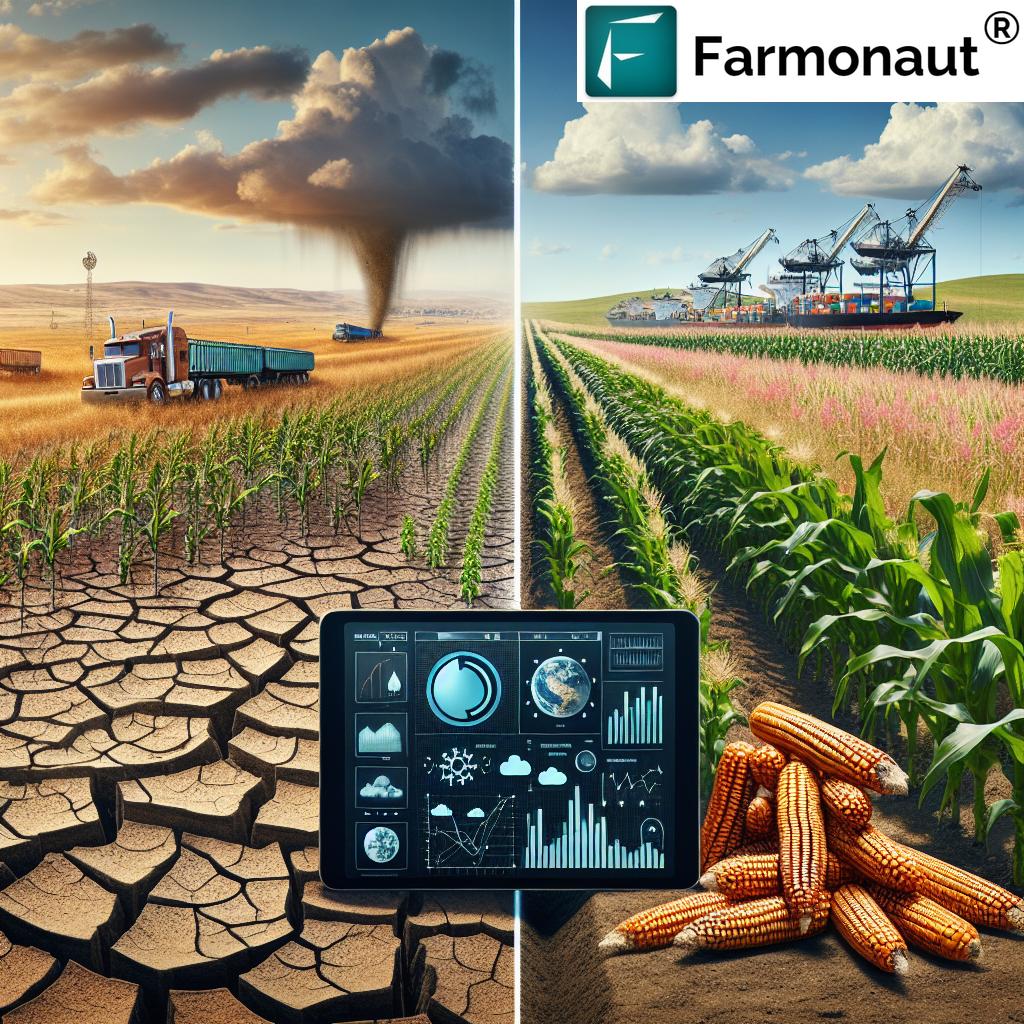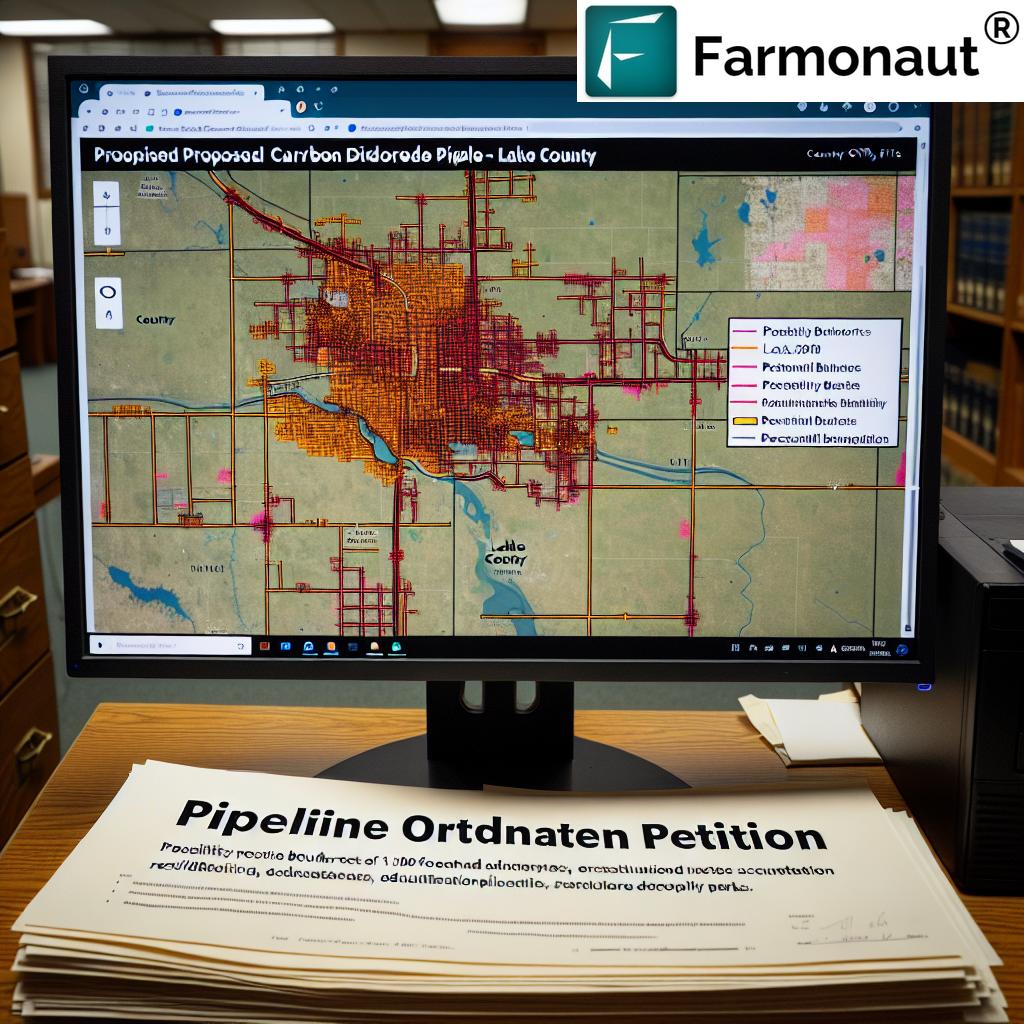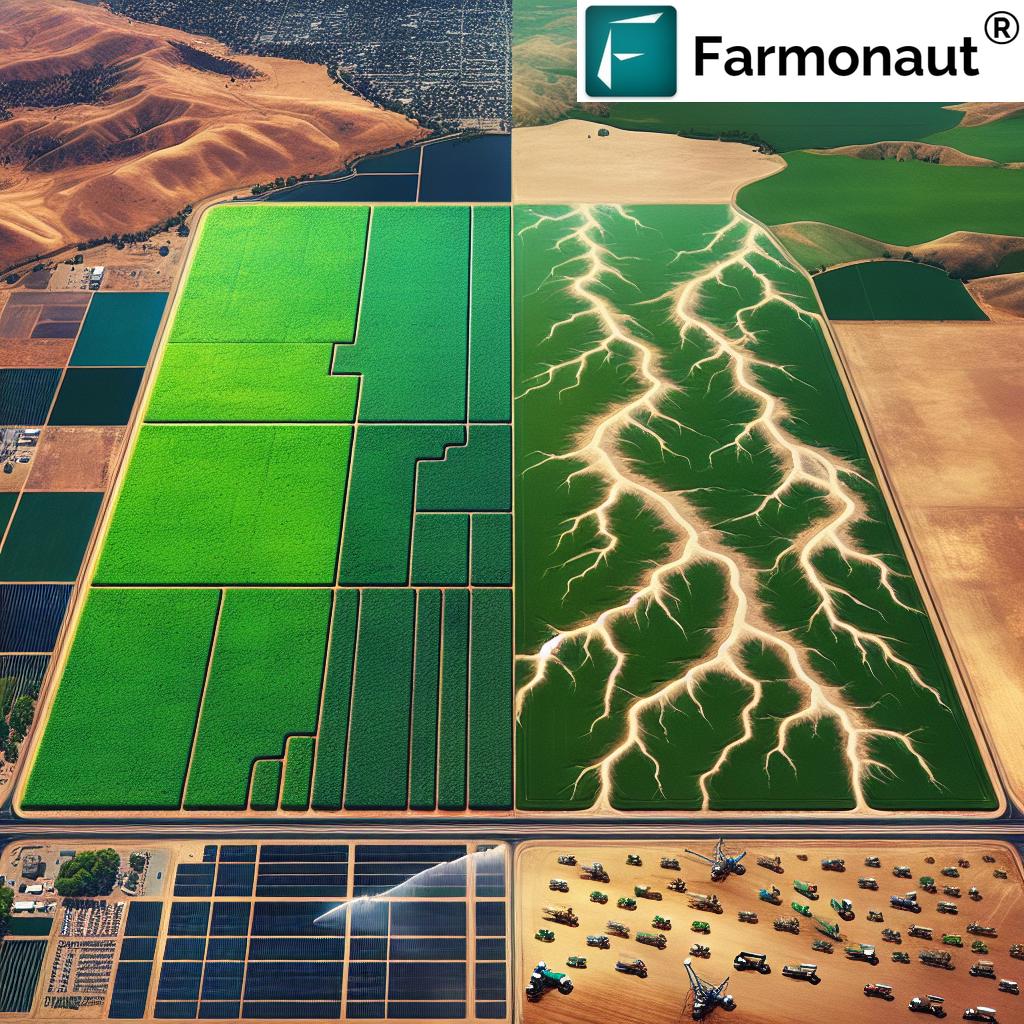2024 Corn Harvest Outlook: US Grain Stock Trends and Drought Impact on Crop Yields
“US corn yield forecasts for 2024 vary by up to 20% across regions due to localized drought impacts.”
As we approach the 2024 corn harvest season, the agricultural landscape in the United States is experiencing a dynamic shift. In this comprehensive blog post, we at Farmonaut will explore the intricate factors shaping the corn industry, from grain stock trends to the impact of weather variability on crop yields. Our analysis draws upon the latest data and insights, providing farmers, agribusinesses, and policymakers with valuable information to navigate the challenges and opportunities ahead.

2024 Corn Harvest Forecast: A State-by-State Analysis
The 2024 corn harvest forecast reveals a complex picture across the United States, with significant variations from state to state. Let’s delve into the outlook for some key corn-producing regions:
- Iowa: As the leading corn-producing state, Iowa is facing mixed conditions. While some counties are experiencing favorable weather, others are grappling with localized drought. The overall yield is expected to be slightly below the five-year average.
- Illinois: The Prairie State is anticipating a near-average harvest, with improvements in soil moisture levels compared to previous years. However, late-season heat stress remains a concern for some farmers.
- Nebraska: Drought conditions continue to challenge corn growers in Nebraska, particularly in the western regions. Irrigation management will be crucial for maintaining yields.
- Minnesota: Minnesota’s corn outlook is positive, with favorable spring planting conditions and adequate rainfall throughout the growing season contributing to above-average yield expectations.
- Indiana: The Hoosier State is forecasting a robust corn harvest, benefiting from timely rains and moderate temperatures during key growth stages.
Other states such as Ohio, South Dakota, Wisconsin, and Kansas are also experiencing varied conditions, highlighting the importance of localized agricultural weather monitoring and precision farming techniques.
Grain Stock Trends in US States: Implications for the Corn Market
Understanding grain stock trends is crucial for predicting market dynamics and informing agricultural policy decisions. Here’s an overview of the current situation:
- Midwest: States like Iowa, Illinois, and Indiana are reporting stable to slightly increasing corn stocks, reflecting improved storage practices and strategic inventory management.
- Great Plains: North Dakota and South Dakota are experiencing fluctuating grain stocks due to variable weather patterns and shifting crop rotations between corn and soybeans.
- Southern States: Texas and Georgia are showing a trend towards decreased corn stocks, as farmers in these regions diversify into other crops or face challenges from prolonged dry spells.
These grain stock trends have significant implications for corn prices, export potential, and domestic consumption patterns. Farmers and agribusinesses must stay informed about these trends to make strategic decisions about planting, storage, and marketing.
Agricultural Drought Impact on Yields: Strategies for Resilience
Drought conditions continue to be a major concern for corn growers across several US states. The impact of agricultural drought on yields varies significantly:
- Severe Impact: Parts of Nebraska, Kansas, and Colorado are facing severe drought conditions, with potential yield reductions of 20-30% in non-irrigated fields.
- Moderate Impact: States like Missouri, Iowa, and Illinois are experiencing pockets of moderate drought, leading to localized yield decreases of 10-15%.
- Minimal Impact: Minnesota, Wisconsin, and Michigan are largely avoiding drought conditions, with yields expected to remain stable or even increase in some areas.
To mitigate the impact of drought, farmers are increasingly turning to innovative solutions:
- Precision Irrigation: Utilizing advanced soil moisture sensors and satellite-based crop health monitoring to optimize water usage.
- Drought-Resistant Varieties: Planting corn hybrids specifically bred for improved performance under water-stressed conditions.
- Conservation Tillage: Implementing practices that enhance soil moisture retention and reduce evaporation.
- Cover Cropping: Using cover crops to improve soil health and water-holding capacity during fallow periods.
At Farmonaut, we provide farmers with cutting-edge tools for agricultural weather monitoring and crop health assessment, enabling them to make data-driven decisions in the face of drought challenges.
Corn Disease Identification Techniques: Safeguarding Crop Health
“Precision agriculture technologies have increased corn disease identification accuracy by 30% in recent years.”
Effective corn disease management is crucial for maintaining high yields and grain quality. Modern corn disease identification techniques are revolutionizing how farmers approach crop health:
- Multispectral Imaging: Using satellite and drone-based sensors to detect early signs of disease stress before visible symptoms appear.
- AI-Powered Diagnostics: Leveraging machine learning algorithms to analyze leaf images and provide rapid, accurate disease identification.
- IoT Sensors: Deploying in-field sensors to monitor environmental conditions conducive to disease development.
- Molecular Testing: Utilizing PCR-based techniques for precise identification of pathogens, enabling targeted treatment strategies.
These advanced techniques are particularly important for managing diseases such as gray leaf spot, northern corn leaf blight, and tar spot, which can significantly impact corn yields if left unchecked.
Farmers across states like Iowa, Illinois, and Indiana are increasingly adopting these technologies to stay ahead of potential disease outbreaks. Educational initiatives, often supported by state agricultural extension services, are playing a crucial role in disseminating knowledge about these cutting-edge corn disease management approaches.
Explore Farmonaut’s API for advanced crop monitoring
International Corn Trade Relations: Shaping the Global Market
The landscape of international corn trade is evolving, with significant implications for US producers and global food security. Key developments include:
- China-US Relations: Despite political tensions, China remains a major buyer of US corn, with import volumes expected to remain strong in 2024.
- Mexico’s GMO Policies: Ongoing discussions about Mexico’s proposed restrictions on genetically modified corn imports from the US could impact trade flows.
- Emerging Markets: Countries in Southeast Asia and Africa are increasing their corn imports, presenting new opportunities for US exporters.
- Competition from Brazil: Brazil’s expanding corn production and export capacity are challenging US market share in key Asian markets.
These international trade dynamics are influencing planting decisions and market strategies for US corn farmers. States with significant export infrastructure, such as Louisiana and Washington, are particularly attuned to these global trends.

Precision Agriculture Technology: Revolutionizing Corn Production
The adoption of precision agriculture technology is transforming corn production across the United States. These advanced tools are enabling farmers to optimize inputs, increase yields, and reduce environmental impact:
- Variable Rate Technology (VRT): Allowing for precise application of fertilizers and pesticides based on soil and crop needs.
- GPS-Guided Machinery: Improving planting and harvesting efficiency while reducing fuel consumption and soil compaction.
- Remote Sensing: Using satellite and drone imagery to monitor crop health and identify issues early.
- Predictive Analytics: Leveraging big data and machine learning to forecast yields and optimize farm management decisions.
States like Iowa, Illinois, and Nebraska are at the forefront of precision agriculture adoption, with many farmers reporting significant improvements in productivity and sustainability.
Sustainable Farming Practices in Corn Production
Sustainability is becoming increasingly important in the corn industry, driven by environmental concerns and consumer demand for responsibly produced food. Key sustainable farming practices include:
- Conservation Tillage: Minimizing soil disturbance to improve soil health and reduce erosion.
- Cover Cropping: Planting cover crops to enhance soil fertility and prevent nutrient runoff.
- Integrated Pest Management (IPM): Using a combination of biological, cultural, and chemical methods to control pests while minimizing environmental impact.
- Precision Nutrient Management: Applying fertilizers based on precise soil and crop needs to reduce waste and environmental pollution.
States like Minnesota, Wisconsin, and Ohio are implementing policies and incentives to promote these sustainable practices among corn growers. The adoption of these methods not only benefits the environment but also often leads to long-term cost savings for farmers.
Crop Yield Optimization Strategies: Maximizing Corn Production
Farmers across the US are employing various strategies to optimize corn yields in the face of changing climate conditions and market demands:
- Hybrid Selection: Choosing corn varieties tailored to local growing conditions and resistant to prevalent diseases.
- Planting Date Optimization: Adjusting planting schedules based on long-term weather forecasts and soil conditions.
- Soil Health Management: Implementing practices to improve soil structure, organic matter content, and microbial activity.
- Water Management: Utilizing efficient irrigation systems and soil moisture monitoring to optimize water use.
- Nutrient Management: Employing precision fertilization techniques to match nutrient application with crop needs at different growth stages.
These strategies are being implemented with varying degrees of success across different states. For instance, farmers in California are focusing on water-efficient practices, while those in Iowa are emphasizing soil health management to combat erosion and improve fertility.
State-Level Policy Changes Affecting Corn Production
Various states are implementing policy changes that directly impact corn production and the broader agricultural sector:
- Iowa: Expanding conservation programs to incentivize sustainable farming practices and water quality improvements.
- Illinois: Implementing new regulations on fertilizer application to reduce nutrient runoff into waterways.
- Nebraska: Developing policies to support drought resilience and water conservation in agriculture.
- Minnesota: Introducing initiatives to promote the use of corn-based biofuels and support rural economic development.
- Ohio: Enhancing programs to support beginning farmers and facilitate farmland transition to the next generation.
These policy changes reflect the evolving priorities of state governments in addressing environmental concerns, supporting rural communities, and ensuring the long-term sustainability of corn production.
Educational Initiatives on Corn Disease Management
Across the corn belt, educational initiatives are playing a crucial role in enhancing farmers’ knowledge and skills in disease management:
- Extension Programs: State universities are offering workshops and field days to demonstrate the latest disease identification and management techniques.
- Online Learning Platforms: Digital resources and webinars are making expert knowledge more accessible to farmers in remote areas.
- Farmer-to-Farmer Networks: Peer learning groups are facilitating knowledge sharing and best practice adoption among corn growers.
- Industry Partnerships: Collaborations between seed companies, agrochemical firms, and research institutions are driving innovation in disease-resistant varieties and control methods.
These educational efforts are particularly important in states like Indiana, Illinois, and Iowa, where corn diseases can significantly impact yields and grain quality.
2024 US Corn Production Outlook: Regional Trends and Factors
| Region | Estimated Yield (bushels/acre) | Drought Impact | Grain Stock Trend | Precision Agriculture Adoption Rate (%) | Key Disease Concerns |
|---|---|---|---|---|---|
| Midwest (IA, IL, IN) | 180-200 | Medium | Stable | 75% | Gray Leaf Spot, Tar Spot |
| Great Plains (NE, KS, SD) | 150-170 | High | Decreasing | 60% | Goss’s Wilt, Fusarium Stalk Rot |
| Southeast (GA, AL, NC) | 140-160 | Low | Increasing | 50% | Southern Corn Leaf Blight, Aflatoxin |
| Northeast (PA, NY, OH) | 160-180 | Low | Stable | 55% | Northern Corn Leaf Blight, Eyespot |
The Role of Technology in Shaping the Future of Corn Production
As we look towards the future of corn production in the United States, technology will play an increasingly vital role in addressing challenges and maximizing opportunities. At Farmonaut, we’re at the forefront of this technological revolution, providing farmers with powerful tools for crop monitoring, disease detection, and yield optimization.
Our satellite-based crop health monitoring system allows farmers to track NDVI (Normalized Difference Vegetation Index) and other critical metrics throughout the growing season. This real-time data enables quick responses to emerging issues, whether it’s drought stress, nutrient deficiencies, or disease outbreaks.
Furthermore, our AI-powered advisory system, Jeevn AI, provides personalized recommendations based on field-specific data, helping farmers make informed decisions about irrigation, fertilization, and pest management. By integrating these advanced technologies into their operations, corn growers across the country can improve their resilience to climate variability and market fluctuations.
Access Farmonaut’s API Developer Docs for integration
Conclusion: Navigating the Future of US Corn Production
As we’ve explored in this comprehensive overview, the 2024 corn harvest outlook is shaped by a complex interplay of factors, including weather patterns, technological advancements, policy changes, and global market dynamics. While challenges such as drought and disease pressure persist, the industry is responding with innovative solutions and sustainable practices.
Farmers, agribusinesses, and policymakers must remain adaptable and informed to navigate the evolving landscape of corn production. By embracing precision agriculture technologies, implementing sustainable farming practices, and staying attuned to market trends, the US corn industry can continue to thrive and meet the growing global demand for this crucial crop.
At Farmonaut, we’re committed to supporting this journey by providing cutting-edge tools and insights that empower farmers to make data-driven decisions and optimize their operations. Together, we can build a more resilient, productive, and sustainable future for corn production in the United States.
FAQ Section
- Q: How is the 2024 corn harvest expected to compare to previous years?
A: The 2024 corn harvest is expected to show regional variations due to localized weather patterns and drought impacts. Overall, yields may be slightly below the five-year average in some areas, while others could see improvements due to advanced farming techniques and favorable conditions. - Q: What are the main factors affecting corn grain stocks in the US?
A: The main factors influencing corn grain stocks include weather conditions, planting acreage decisions, export demand, domestic consumption (including ethanol production), and carryover from previous seasons. - Q: How are farmers adapting to drought conditions in corn production?
A: Farmers are adapting to drought conditions through various strategies, including the use of drought-resistant corn varieties, implementing precision irrigation techniques, adopting conservation tillage practices, and utilizing satellite-based crop monitoring for early stress detection. - Q: What role does precision agriculture play in modern corn farming?
A: Precision agriculture plays a crucial role in modern corn farming by enabling targeted application of inputs, optimizing resource use, improving yield forecasting, and facilitating early detection of crop health issues through technologies like GPS-guided machinery, remote sensing, and AI-powered analytics. - Q: How are international trade relations affecting the US corn market?
A: International trade relations significantly impact the US corn market through factors such as export volumes to major buyers like China, potential policy changes in importing countries (e.g., Mexico’s GMO corn policies), competition from other exporting nations like Brazil, and emerging market demand in Asia and Africa.
















